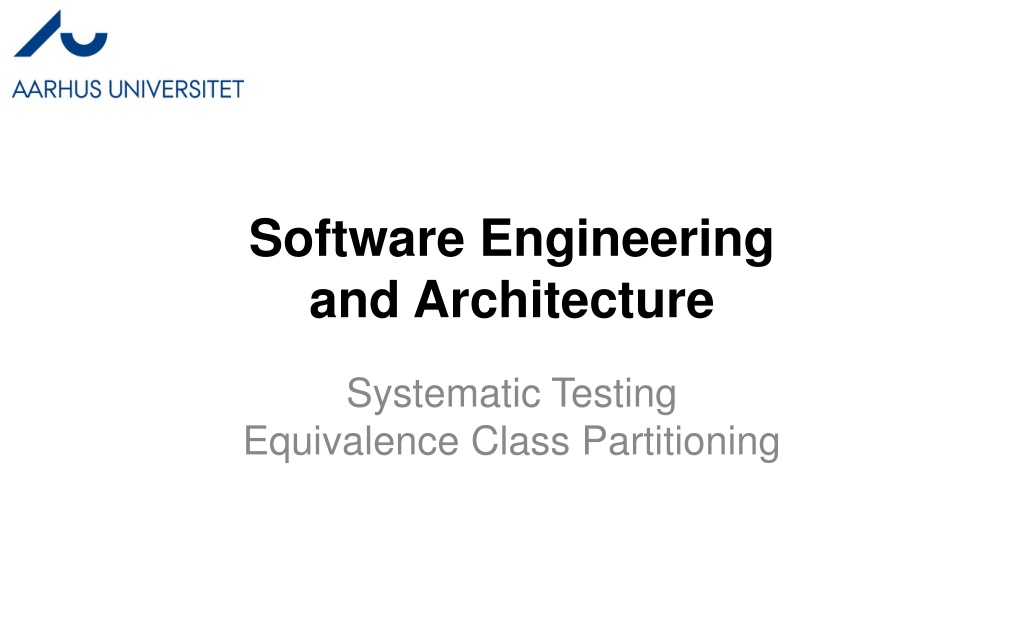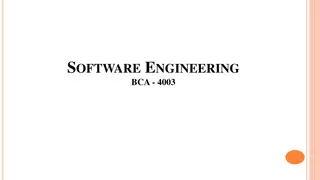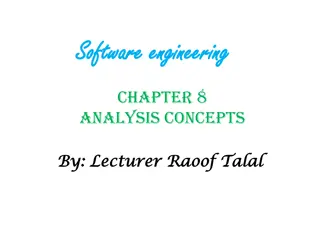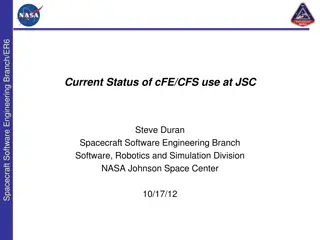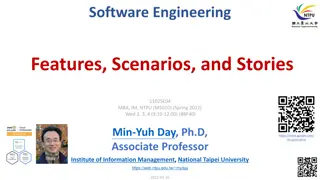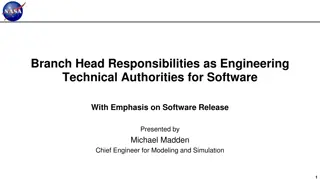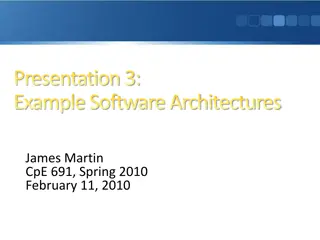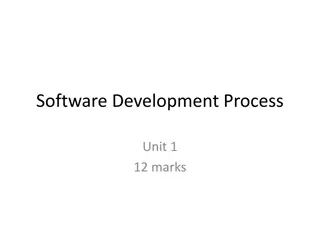Software Engineering and Architecture
Reliability in software systems is crucial, as defects can lead to failures impacting reliability. The number of defects directly affects the system's reliability. Not all defects are equal, so prioritizing defect correction based on return on investment is essential. Testing thoroughly, especially in complex software like Firefox, is key to identifying defects. Various testing techniques and the impact of code complexity on defect probability are explored in this insightful discussion.
Download Presentation

Please find below an Image/Link to download the presentation.
The content on the website is provided AS IS for your information and personal use only. It may not be sold, licensed, or shared on other websites without obtaining consent from the author.If you encounter any issues during the download, it is possible that the publisher has removed the file from their server.
You are allowed to download the files provided on this website for personal or commercial use, subject to the condition that they are used lawfully. All files are the property of their respective owners.
The content on the website is provided AS IS for your information and personal use only. It may not be sold, licensed, or shared on other websites without obtaining consent from the author.
E N D
Presentation Transcript
Software Engineering and Architecture Systematic Testing Equivalence Class Partitioning
What is reliability? If there is a defect, it may fail and is thus not reliable. Thus: Reduce number of defects will reduce number of failures will increase reliability CS@AU Henrik B rbak Christensen 2
Discussion True? Find example of removing a defect does not increase the system s reliability at all Find example of removing defect 1 increase reliability dramatically while removing defect 2 does not CS@AU Henrik B rbak Christensen 3
All defects are not equal! So given a certain amount of time to find defects (you need to sell things to earn money!): What kind of defects should you correct to get best return on investment? CS@AU Henrik B rbak Christensen 4
Example Firefox has an enormous amount of possible configurations! Imagine testing all possible combinations! Which one would you test most thoroughly? CS@AU Henrik B rbak Christensen 5
Testing Techniques CS@AU Henrik B rbak Christensen 6
One viewpoint The probability of defects is a function of the code complexity. Thus we may identify (at least) three different testing approaches: No testing. Complexity is so low that the test code will become more complex or longer. Example: set/get methods Explorativetesting: gut feeling , experience. TDD relies heavily on making the smart test case but does not dictate any method. CS@AU Henrik B rbak Christensen 7
Destructive! Testing is a destructive process!!! In contrast to almost all other SW processes which are constructive! Human psychology I want to be a success The brain will deliver! (ok, X-factor shows this is not always the case ) I will prove my software works I will prove my software is really lousy CS@AU Henrik B rbak Christensen 8
Morale: When testing, reprogram your brains I am a success if I find a defect. The more I find, the better I am! CS@AU Henrik B rbak Christensen 9
Our focus There are a lot of different testing techniques. Types: In our course two black box techniques: Equivalence class partitioning (EC) Boundary value analysis (which is actually associated with EC) CS@AU Henrik B rbak Christensen 10
Equivalence Class Partitioning Often just called EC testing
Consider Math.abs(x): Absolute value of x If x is not negative, return x. If x is negative, return the negation of x. Will these five test cases ensure a reliable implementation? CS@AU Henrik B rbak Christensen 12
Two problems A) what is the probability that x=38 will find a defect that x=37 did not expose? B) what is the probability that there will be a defect in handling negative x? CS@AU Henrik B rbak Christensen 13
Core insight We can find a single input value that represents a large set of values when it comes to finding defects! An EC is a (sub)set. Da: Delm ngde So we only need one test case representing that set CS@AU Henrik B rbak Christensen 14
For Math.abs ECs are subsets of the full input set. -42 +39 +37 -92431523 EC-1 EC-2 X = - 42 | 42 CS@AU Henrik B rbak Christensen 15
The argumentation The specification will force an implementation where (most likely!) all positive arguments are treated by one code fragment and all negative arguments by another. Thus we only need two test cases: 1) one that tests the positive argument handling code 2) one that tests the negative argument handling code For 1) x=37 is just as good as x=1232, etc. Thus we simply select a representative element from each EC and generate a test case based upon it. CS@AU Henrik B rbak Christensen 16
Note Systematic testing ... does not mean Systematically find all defects and guaranty none are left!!! If you need proofs, you need my colleagues research does mean Systematically derive a small set of test cases with high probability of finding many defects!!! CS@AU Henrik B rbak Christensen 17
Specifically Systematic testing cannot in any way counter malicious programming Virus, easter eggs, evil-minded programmers (really really incompetent programmers) CS@AU Henrik B rbak Christensen 18
A Sound EC partitioning For our ECs to be sound: CS@AU Henrik B rbak Christensen 19
Exercise Coverage? Representation? -42 +39 +37 -92431523 EC-1 EC-2 CS@AU Henrik B rbak Christensen 20
Exercise The classic blunder at exams! Representation = two values from the same EC will result in the samebehaviour in the algorithm Argue why this is completely wrong! Consider for instance the Account class deposit method account.deposit(100); account.deposit(1000000); CS@AU Henrik B rbak Christensen 21
Documenting ECs Math.abs is simple. Thus the ECs are simple. This is often not the case! Finding ECs requires deep thinking, analysis, and iteration. Document them! Equivalence class table: Label the EC CS@AU Henrik B rbak Christensen 22
Invalid/Valid ECs Some input values make an algorithm give up, bail out, throw exception, orcompute answer immediately: file.open( nonexisingfile ); g.moveUnitTo([mountain]) Input values that leads to abnormal processing/giving up we classify as belonging to invalid ECs. Those input values that process normally we say belong to valid ECs. Those cases where the method is run to conclusion CS@AU Henrik B rbak Christensen 23
Finding the ECs Often tricky
Reality Example: Backgammon move validation validity = v (move, player, board-state, die- value) is Red move (B1-B2) valid on this board given this die and this player in turn? Problem: multiple parameters: player, move, board, die complex parameters: board state coupled parameters: die couples to move! EC boundary is not a constant! CS@AU Henrik B rbak Christensen 25
A process To find the ECs you will need to look carefully at the specification and especially all the conditions associated. Conditions express choices in our algorithms and therefore typically defines disjoint algorithm parts! If (expr) {} else {} And as the test cases should at least run through all parts of the algorithms, it defines the boundaries for the ECs. And consider typical programming techniques Will a program contain if s and while s here? CS@AU Henrik B rbak Christensen 26
Partitioning Heuristics 1) If you have a range of values specification make three ECs: [1] in range [2] above range [3] below range valid invalid invalid Ex. Standard chess notation/ is a8 or x17 valid positions? Column range: a-h; Row range: 1-8 CS@AU Henrik B rbak Christensen 27
Partitioning Heuristics 2) If you have a set, S, of values specification make |S|+1 ECs [1]..[|S|] one for each member in S [|S|+1 for a value outside S valid invalid Ex. PayStation accepting coins Set of {5, 10, 25} cents coins Note: Not just two sets! CS@AU Henrik B rbak Christensen 28
Partitioning Heuristics 3) If you have a boolean condition specification make two ECs Ex. the first character of identifier must be a letter the object reference must not be null you get it, right? CS@AU Henrik B rbak Christensen 29
Partitioning Heuristics 4) If you question the representation property of any EC, then repartition! Split EC into smaller ECs Examples: shortly CS@AU Henrik B rbak Christensen 30
Test case generation For disjoint ECs you simply pick an element from each EC to make a test case. Extended test case table Augmented with a column showing which ECs are covered! CS@AU Henrik B rbak Christensen 32
Usual case ECs are seldom disjoint so you have to combine them to generate test cases. Ex. Chess board validation CS@AU Henrik B rbak Christensen 33
Combinatorial Explosion Umph! Combinatorial explosion of test cases . Ex. Three independent input parameters foo(x,y,z) Four ECs for each parameter That is: x s input set divided into four ECs, y s input set divided into four ECs, etc. Question: How many test cases? CS@AU Henrik B rbak Christensen 34
Combinatorial Explosion Answer: 43= 64 test cases TC1: [ECx1],[ECy1],[ECz1] TC2: [ECx1],[ECy1],[ECz2] TC4: [ECx1],[ECy1],[ECz4] TC5: [ECx1],[ECy2],[ECz1] TC9: [ECx1],[ECy3],[ECz1] TC64: [ECx4],[ECy4],[ECz4] CS@AU Henrik B rbak Christensen 35
Myers Heuristics Often, it is better to generate test cases like this: Rule 2 Rule 1 CS@AU Henrik B rbak Christensen 36
Why Rule 2? Due to masking One correct test masks a later incorrect test Ex. assertThat(b.valid( ,0)), is(false)); Test case ( ,0) will pass which is expected Code deemed correct, but this is a wrong conclusion! It was the column test that returned false so the defect in the row conditions is masked CS@AU Henrik B rbak Christensen 37
Why Rule 1? You may combine as many valid ECs as possible and cover it with only a single test case until all valid ECs are exhausted Why? Because I must assume that all elements from ECs are used to compute the final result. Any defects will thus most likely show up even if the defect only relate to one element. Ex. bankdayNumberInYear(int month, int day) return 30*month+day Jan = 1; Feb = 2 CS@AU Henrik B rbak Christensen 38
The Process The Summary
Revisited 5. Review the generated test cases carefully to find what you missed and iterate! CS@AU Henrik B rbak Christensen 40
